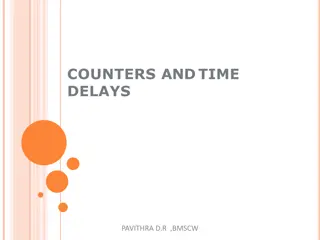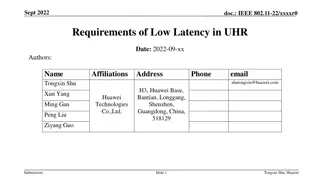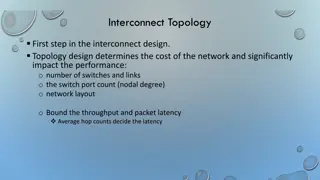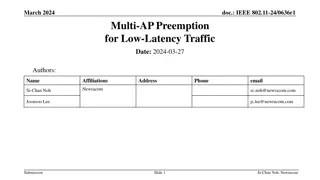Understanding Network Latency and Delays
Dive into the world of computer networking with this informative Q&A session from a CS 332 class. Explore concepts such as network latency, access vs. queuing delays, the different kinds of delays, goodput, and the relationship between capacity and throughput. Gain insights into how propagation delay affects throughput and discover the intricacies of measuring data transfer efficiency in a network.
Download Presentation

Please find below an Image/Link to download the presentation.
The content on the website is provided AS IS for your information and personal use only. It may not be sold, licensed, or shared on other websites without obtaining consent from the author. Download presentation by click this link. If you encounter any issues during the download, it is possible that the publisher has removed the file from their server.
E N D
Presentation Transcript
Ch. 28 Q and A CS 332 Fall 2017
A little quiz Q: What is network latency? 1. Changes in delay and duration of the changes 2. time required to transfer data across a network 3. amount of data that can be transferred, per unit time. A: 2.
Another little quiz Q: What do we call the amount of data that can be transferred per unit time? And what units do we use to measure it? A: capacity, in bits per second.
Access vs. Queuing Delays Q: What is the difference between access and queuing delays? A: Access delays is waiting for others to be quiet so that you can send without collisions. Or, waiting for your transmission slot to come around again (in TDM). Queuing delay is a packet sitting in a queue of packets, waiting to get to the front of the queue to be sent.
Average size of the delays Q: How do the five different kinds of delays compare in terms of average length? A: I d have to guess on these server delay < propagation delay < switching delay < access delay < queuing delay. This is a total guess.
Goodput Q: Can you provide a better definition of goodput? A: Maybe Goodput is the amount of layer 5 data that gets through per unit time. Throughput is the total # of bits that get through per unit time. Small packets lower goodput. Larger headers lower goodput.
Capacity and throughput Q: What is the relationship between these two? A: Capacity is the maximum throughput possible. (by definition, but not used consistently in the book or in my speaking )
Propagation delay vs. throughput Q: If propagation delay is a constant, how can networks have varying throughput? I.e., if 10 Mbps and 100 Mbps both use cat5e copper, how can they provide different throughputs? A: It depends on how efficiently the data can be encoded (and especially decoded) on the medium.
Specifying throughput Q: If Calvin has two links to the Internet (through US Signal), each at 500 Mbps, what is the capacity of our link to the world? A: Hard to say. It could be 500 Mbps or 250 Mbps, or 1000 Mbps depending on the connection type, contract, etc. This demonstrates the difficulty of specifying throughput.
Network perf == 6thlayer? Q: In a sense, would it be fair to say that network performance is almost a sixth layer in the stack? That is, since it is supposed to provide info regardless of application (layer 5), is it kind of another layer? A: I don t think so. I think of layering as strictly encapsulation header and payload from one layer becomes the payload of the layer below.
Heisenberg? Q: Is it fair to say that there is a kind of Heisenberg Uncertainty Principle in network performance measurement? That is, the fact that you are measuring affects what you are measuring, so it is impossible to get a totally objective measurement? A: You could almost say that, because, yes, it is hard to get a measure of network performance by using the network.
Buy more throughput? Q: How can you buy more throughput? A: Upgrade your service plan. At home I can get 4 Mbps or 8 Mbps or 12 or 20 or 40 Done by buying more virtual channels from the ISP. The channels are used in parallel to send bits. Thus, more throughput.
Asymmetric routes Q: The book mentions asymmetric routes as a difficulty for network measurements. How does it make it difficult? A: Traffic from client to server could take one route and traffic from server to client could take another longer or shorter route. So, round-trip time is accurate but does not represent either half correctly.
Jitter (1) Q: What units are used to specify jitter? A: I don t know Must be time units. Q: How do you measure jitter? A: You look at the arrival time of consecutive packets (assuming the packets are sent out with consistent timing).
Jitter (2) Variation in delay. Lower jitter is better. Jitter is the change in latency from packet to packet. RFC 4689 defines jitter as the absolute value of the difference between the forwarding delay of two consecutive received packets belonging to the same stream. Easier or harder than delay to measure? Do not need to know delay to compute variation of delay. Just need to measure packet-to-packet change.
Quiz Q: If all packets in a stream have the same delay, what is the value of the jitter? A: 0
Jitter vs. Delay Q: Is high amounts of Jitter worse or better then high amounts of Delay? A: Worse, probably.
Why keep utilization relatively low? Q: I found it interesting that most ISPs try to keep their total utilization threshold under 50%. Why do this? A: It leaves room for bursty traffic which will happen. Also, consider the formula that estimates current delay: D = D0/ (1 U).
Delay and Throughput Q: Are delay and throughput independent or not? A: Theoretically independent, but practically not. Traffic on one link: independent. Traffic flowing across multiple links: dependent.
Delay-throughput product Q: Can you give an example of when you would care about the delay-throughput product? A: Sure! Q: What is the definition of it? A: How much data is in transit at a time. Why is it important? Can mask long delay by putting lots of data in the pipeline. If link goes down, you lose lots of data, and have to retransmit lots of data.
Use average? Q: Since traffic is bursty, do people use an average? What measurement do they use? The delay-throughput product or just admit data traffic is kind of spotty? A: I think an average is common or an average and a maximum.
Q3 Q3: What is "access delay"? (Hint: you see it when using an Ethernet NIC.) A: The time for a packet to get access to the network.
When are delay and throughput not independent? Over a single network (LAN), delay and throughput are independent. But, over a series of LANs with switches/routers in between, they become related. Queuing delay in a switch leads to lower throughput. Queuing delay caused by busy links. Effective delay D = D0/ (1 U)
Q5 Q: What is the capacity of a 10base100 Ethernet line? A: 100 Mbps
Q6 Q: If Calvin has two links to the Internet (through US Signal), each at 500 Mbps, what is the capacity of our link to the world? A: Hard to say. It could be 500 Mbps or 250 Mbps, or 1000 Mbps depending on the connection type, contract, etc.
Q7 Q: How does throughput compare to goodput? 1. throughput is the same as goodput 2. throughput is always less than goodput 3. throughput is sometimes less than goodput and sometimes more than goodput 4. throughput is always more than goodput 5. All of the above. A: 2.
Q9 Q: Throughput and delay are theoretically independent. Explain why they are practically dependent on each other. A: When congestion occurs along a route (at an "intersection"), then packets going along that route will be delayed and throughput will go down.
Q10 Q: What is the significance of the delay- throughput product? A: It is a measure of how much data is in transit at any one time. It is significant because if there is a connection problem, then all the data that is in transit at one time that has to be retransmitted.
5 Parts of Delay Q: Can you explain the 5 types of delay a bit more? A: Sure: 1) Propagation Delay: delay of moving a signal across a network even light does not travel infinitely fast. 2) Access Delay: a device waiting for a cable/fiber to be clear before it can send. 3) Switching Delay: routing a packet. 4) Queuing Delay: delay from statistical multiplexing 5) Server Delay: (not really networking) time for a server to formulate a response to a query.
A No-Delay Network Q: Would it be theoretically possible to create a network with no delay? A: Yes! Using quantum physics. Or not
Measuring delay Q: How can we measure and print out the delay of a packet or packets moving across a network? A: This is hard! Perhaps You measure round-trip times. Divide by 2, but then assumes delays are identical each direction which is not true most of the time. Put timestamps into the packets. But, these are not that useful.
Throughput vs. Goodput Q: Can you explain goodput better? A: Sure! Goodput is the measure of how much *data* can be sent over the network not including any network protocol overhead. E.g., Link has 200 Bps max throughput. But, its layer 2 header is 100 bytes. So, only 100 Bps max of *data* can get through. Throughput is 200 Bps; goodput is 100 Bps.
The Road Analogy Q: Can you explain the road/traffic analogy more? A: Why, yes. Yes, I can. Delay is theoretically independent of capacity.
Real-time Protocols and Jitter Q: How do real-time protocols account for jitter? A: Read chapter 29. Example: sending real-time video over the internet Facetime or Skype. First, why not use TCP? RTP sends timestamps in each packet, so users of RTP can implement a jitter buffer. Packets are released from the buffer with no jitter.
Isochronous networks Q: Can you explain isochronous networks? A: Not really. But, it must be a network that sets up / reserves bandwidth and processing capacity across each hop in the network before traffic flows (circuit-switching). E.g., Multiprotocol Label Switching (MPLS) or ATM (Asynchronous Transfer Mode) at Layer 2.
Goodput Q: Can you clarify "Goodput"? A: Goodput is how much data gets through per unit time. It is throughput overhead (sort of). Q: How is goodput measured? A: You could transfer data and see how much gets through in a certain amount of time. Or compute max goodput on paper, if you know exactly the overhead of the protocols.
Bandwidth, throughput, latency, delay, goodput Arrrgggh! Q: What does "bandwidth" really mean? A: Bandwidth is how much data can get through the network per unit time how much can be pushed through the network. Q: What about analog bandwidth? A: I m not really sure about this
Cable vs. Satellite ISP Q: If a satellite internet company and a cable internet company advertise the same network speed, say 5 mbps, would the effective data rate of the satellite network be slower because of more latency? A: The bandwidth could be the same, but the delay is probably going to be much longer for the satellite, just because of propagation delay.
Measuring throughput Q: Is throughput measured solely on the hardware in the network, for example 1Gbps ethernet? A: You can measure the throughput of a link, but it is much more interesting to measure the throughput of a network or a path through multiple networks.
Jitter Q: What exactly is jitter? A: Jitter is the variation in delay for a set of packets. If packets are sent out, say 1 every 1 ms, but arrive with differing gaps, that s jitter. If one gap is 1ms, the next 2 ms, the next 0.5 ms, etc that s jitter.
Importance of formula 28.1 Q: What is the significance of formula 28.1? A: It helps estimate delay based on utilization. Utilization is how busy a network is how many packets are queued up to get sent.
Measuring network performance Q: What other methods are there for measuring the network performance apart from ping? Is ping a good indicator for the speed of the internet between 2 hosts? A. ping measures RTT (round-trip time), i.e., delay, which is an important metric. Other tools are: mtr, SNMP, ttcp, iperf, etc.
Making up for jitter Q: p 476. The internet uses real-time protocols to compensate for jitter. Could you explain how that is done in a nutshell? A. The Real-time Transport Protocol (RTP) is sort-of half way between UDP and TCP. There are reliability mechanism in place like TCP, but data is dropped/skipped if it goes missing (retransmission is useless for real-time). Also, the protocol buffers data at the receiver so that it can deliver it consistently when it has enough data.
Over-booking? Q: In the book it talked about most network admins not utilizing a network higher than 90%, is this the case with moth ISPs? I feel the service comcast or at&t provides varies wildly from hour to hour. Is this a result of them over booking their network? A: I have no idea. Could be. But, the internet is very bursty, as Comer says.























